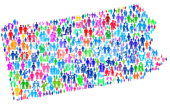Cell: 717-599-2077
Tort Reform Would Keep Medicaid Dollars in Pa
Pennsylvania nursing homes lose $4.96 per day defending against out-of-state suits
HARRISBURG — With the state General Assembly set to return to voting next week as the two-year legislative session begins to wind down, the Pennsylvania Health Care Association is pushing for final passage of a measure that will protect seniors, end lawsuit abuse and help the state’s fiscal situation by keeping limited Medicaid dollars in the commonwealth.
“Pennsylvania nursing homes have become the target out of out-of-state predatory lawyers who are filing frivolous lawsuits seeking huge cash payouts,” said PHCA President and CEO Russ McDaid. “This has nothing to do with the quality of care in these facilities. Instead, it has everything to do with lax tort laws that enable these out-of-state lawyers to take advantage of the system.”
McDaid underscored the importance of Senate Bill 747 during an appearance on a statewide public affairs TV program that begins airing this weekend. The measure passed the Senate in June 2015 and now awaits final action by the House.
Senate Bill 747 is designed to limit punitive damages against long-term care provides to 250 percent of the amount of compensatory damages for long-term care providers, giving them the same protections physicians have had in Pennsylvania since the passage of the MCARE law in 2002.
“In other words, nursing homes aren’t asking for anything new,” McDaid said. “All we’re asking for is the same protections that were afforded to doctors and hospitals.”
When punitive damages are awarded, they can be astronomical. Without protections, providers and their insurers are more likely to settle a weak case than risk a runaway jury that could bankrupt their business. Prior to the protections enacted for physicians, doctors had been facing large numbers of frivolous lawsuits and were settling cases for fear of unpredictable jury verdicts. Since the limits have been put in place, the number of cases has fallen dramatically.
Physicians now litigate 80 percent of malpractice cases because they believe the case will be judged fairly on the merits without the risk of unpredictable punitive damage awards by runaway juries. Nursing homes, on the other hand, currently settle virtually 100 percent of their cases for fear of the very same unpredictable punitive damage awards that existed for physicians before MCARE.
In fact, nursing homes lose an average of $4.96 per day defending against mostly out-of-state predatory trial lawyers. Given that there are about 19.2 million days of care paid for by the commonwealth’s Medicaid program, $95 million was spent on liability related costs in Pennsylvania nursing homes in 2014.
It is important to note, McDaid said, that this legislation does not take away anyone’s right to sue, nor does it limit the compensatory damages that these individuals would be entitled to if a court finds a long-term care provider to be at fault. The measure also leaves unchanged the definition of punitive care in the MCARE law in effect for physicians since 2002.
“Pennsylvania’s population is aging rapidly, and that means significant fiscal and social challenges need to be addressed to ensure residents continue to have access to the high-quality long-term services,” McDaid said. “Most of that $95 million currently being spend on frivolous lawsuits filed by out-of-state lawyers could be used to improve the quality of care and the quality of life for nursing home residents.”
Nursing homes today are more like hospitals, with the acuity (sickness) level of residents continuing to increase. The end result is higher operating costs for nursing homes — many of which serve residents who rely on Medicaid to help cover the costs of their care. Unfortunately, while long-term care costs have increased dramatically, funding for Medicaid residents has not kept pace.
Roughly two-thirds of all nursing home residents rely on Medicaid to pay for their care. However, the state reimburses nursing homes an average of $23 a day less per resident than the true cost of care. That shortfall has almost doubled since 2007, when it totaled $13.23 per resident per day. That means nursing homes on average lose about $8,500 annually for every Medicaid resident in their care.
A new independent study by Avalere Health, a respected Washington, D.C., research company focused on health care, reports that nursing homes have seen their margins drop by 28 percent between 2007 and 2014, from 3.2 percent to 2.3 percent. Those margins dip even lower, from 1.4 percent to 1.2 percent, for facilities where 75 percent or more of residents in care rely on Medicaid.
“Senate Bill 747 would keep millions of Medicaid dollars in Pennsylvania to protect seniors and help us address the critical funding needs we have to ensure our most vulnerable residents have access to the best possible care,” McDaid said.
“Pennsylvania Newsmakers” is one of the state’s premier politics and public policy television talk shows. The show is available at www.phca.org and will air regionally:
• WGAL Channel 8 (Harrisburg and Lancaster) Sunday, September 18 at 11:30 a.m.
• WBPH (Lehigh Valley and Philadelphia) Monday, September 19 at 8:30 p.m.
• WKBS 47 (Altoona) Saturday, September 24 at 9:30 a.m.
• WPCB 40 (Pittsburgh) Saturday, September 24 at 9:30 a.m.

